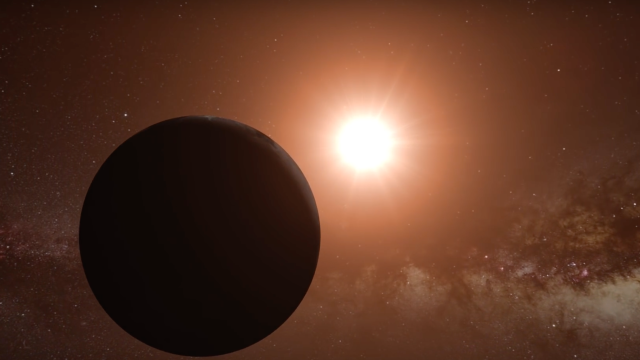Last week, astronomers announced that our nearest neighbouring star hosts an Earth-sized planet in the habitable zone — an exciting prospect for alien life, and a possible second home for humanity. But before we assemble the interstellar welcoming party to greet our cosmic neighbours, we need to figure out whether Proxima b is capable of supporting life at all. Thanks to the James Webb Space Telescope, that question could be answered in less than three years.
Artist’s concept of Proxima b orbiting Proxima Centauri. (Image: ESO./L. Calçada/Nick Resigner)
“It is controversial whether or not life can exist in low mass star systems like Proxima Centauri,” Harvard astronomer Avi Loeb told Gizmodo. “Some people have argued that such planets cannot have an atmosphere.”
That’s why Loeb, along with Harvard astronomer Laura Kreidberg, has just submitted a paper to Astrophysical Journal Letters describing how we can use the JWST — the highly-anticipated successor to Hubble that launches in 2018 — to answer this critical question within just a few days of observation.
The concern that Proxima b may be a dead, airless world stems from the fact that it orbits its dim red dwarf star, Proxima Centauri, at a distance of just 7.5 million kilometres. (Earth, for comparison, is 150 million kilometres from the Sun.) This tight orbit affords Proxima b enough sunlight for Earth-like temperatures and liquid water, but it also subjects the planet to powerful, atmosphere-stripping solar winds. What’s more, it virtually ensures that Proxima b is tidally locked, with a permanent dayside and a permanent nightside. Unfortunately, models suggest that the atmospheres of tidally locked planets may be prone to sudden collapse, as volatile gases freeze out on the nightside.
But atmospheres can also be replenished through volcanic activity, and on planets with strong magnetic fields, they’re less likely to escape. Since we know nothing of Proxima b‘s volcanic activity or magnetic field strength, we can’t even make an educated guess about its prospects of having an atmosphere. But we’re dying to know, because an atmosphere means oceans are possible, and the two together mean life is.
That’s where the JWST comes in. As Loeb and Kreidberg discuss in their paper, the key to sniffing out Proxima b‘s atmosphere lies in the planet’s infrared heat signature. And it just so happens that Hubble’s successor is highly attuned to the infrared part of the spectrum.
“As Proxima b moves about its star, there is no day-night variation,” Loeb explained. “The day side is hot and the night side is cold. But the temperature difference between day and night depends on whether the planet is bare rock, or if it has an atmosphere or ocean, because these redistribute heat.”
In other words, the temperature difference between Proxima b‘s day side and its night side will be larger if there is no atmosphere. In fact, the day side will re-emit all of the energy it absorbs from Proxima Centauri as a blackbody, and we can calculate exactly how much blackbody radiation there should be. The night side, on the other hand, will be hell frozen over.
If the temperature difference between day and night is less extreme, we can infer the presence of an atmosphere. Conveniently, it won’t take long for the JWST to measure IR emissions from both faces of Proxima b as it orbits its star — an entire year only takes 11.2 Earth days.
If Proxima b does have an atmosphere, the next step will be figuring out what it’s made of. We’ll specifically want to look for things like oxygen, water vapour and methane, which could indicate habitable conditions if not active biological processes. This, however, requires us to catch starlight as it bounces off or filters through the planet’s atmosphere — an extraordinarily difficult thing to do. While the JWST might be able to detect a few compounds including ozone, full atmospheric analysis will have to wait for future ground-based observatories like the Extremely Large Telescope, which is expected to see first light in the mid-2020s.
“The important thing is that in a couple of years, we should be able to start learning about the atmosphere [of Proxima b],” Loeb said. “If there is one, it’s quite likely there’d be a call for a special mission to study just this planet.”
As we continue building the tools to study Proxima b from Earth, Loeb is already thinking about how we might pay the planet a visit. He’s chairing the advisory committee for Breakthrough Starshot, a billionaire-backed effort to develop tiny, laser-propelled spacecraft that can travel at up to 20 per cent the speed of light. While Breakthrough Starshot was initially packaged as a voyage to the nearby binary star system Alpha Centauri, the discovery of Proxima b changes everything.
“I think it’s extremely important, psychologically, to have a target,” Loeb said. “If you ask a person to build a ship without knowing where it will sail, it’s quite different than if you have a destination in mind. The fact that we now have a target, in the habitable zone, is very exciting.”
